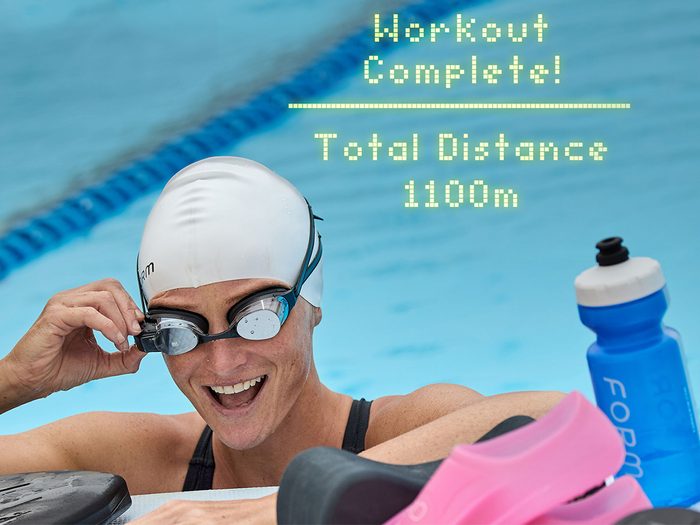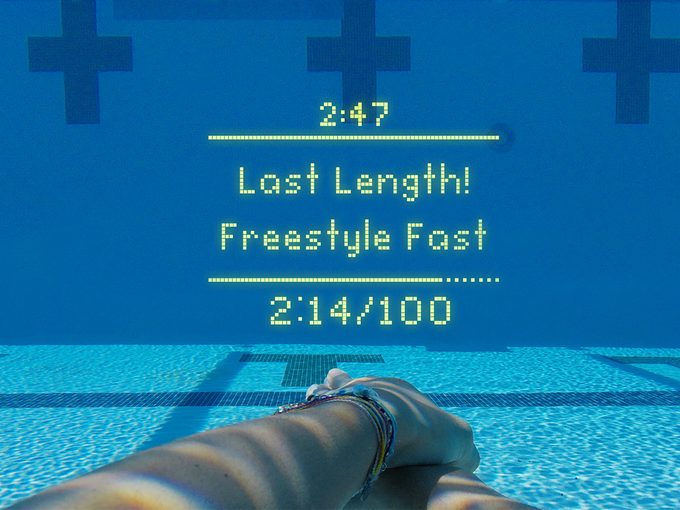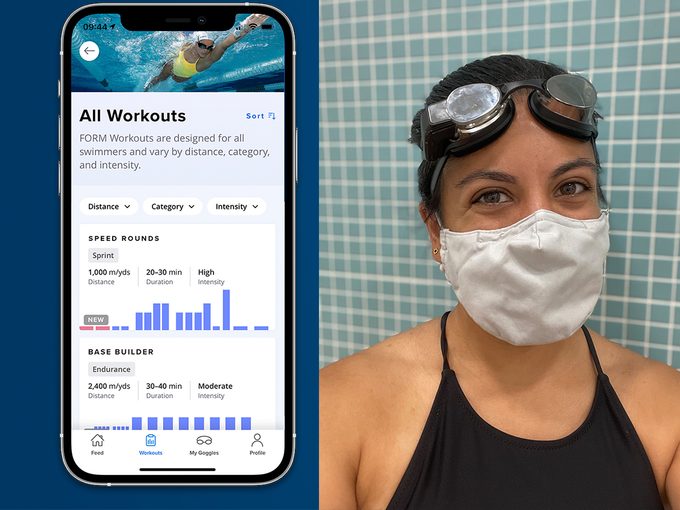These Smart Swim Goggles Bring Fitness Tech Underwater

Swimming is a wonderfully low-tech activity—so do these smart swimming goggles disrupt or enhance the experience?
My version of swimming is standing in a pool or a lake, sometimes with a cocktail in hand. The last time I actually put effort into swimming for any measurable distance was in Grade 6, a casual two decades ago. So you can imagine my trepidation when I decided to dive back into the world of lanes and laps to test out the latest high-tech fitness gear designed for swimmers.
The Smart Swim Goggles, made by Vancouver-based fitness tech company FORM, claim to be the world’s first augmented-reality swim goggles. They offer real-time metrics, like time elapsed and distance travelled, for pool, open water and swim spa swimming. And unlike other fitness gadgets, the display is built right into the lens—yes, like the terminator—so you don’t have to interrupt your workout to check a fitness band or phone app to see how you’re doing. Just keep swimming.

I had read about the many benefits of swimming, a low-impact activity that provides a full-body workout accessible for a vast range of bodies and abilities. I saw this in action at my local community pool, where my fellow swimmers included a fit teenager, as well as an elderly woman who walked with a cane. It’s a fitness environment that felt surprisingly welcoming.
“When I started swimming, I found it a very Zen experience, like it just flowed for me,” says FORM founder and CEO Dan Eisenhardt, who swam competitively for 14 years. He created a heads-up display, which allows the user to see metrics in their field of vision—something he previously built it into ski goggles and cycling glasses. He long hoped to bring this concept into the pool—an arena that has been underserved by technology.
At its basic level, FORM’s wearable tech needs to function as goggles—and it does. It took me a few tries to find the right fit (the goggles come with adjustable straps and nose pieces), but once I did, they never leaked or fogged up. The goggles sync to FORM’s app, which lets users see an impressive range of statistics (like average stroke rate) and follow other swimmers, creating a sort of virtual swim club.
(Related: The Health Benefits of Open-Water Swimming)
Initially, I wondered whether these goggles would disrupt the beauty of one of the last remaining low-tech activities. With the latest watches and apps, my every movement is measured and tracked. The pool offered a rare opportunity to unplug.
The customizable in-goggle display, shown in the upper right corner of my field of vision, seemed simple at first. The pixelated yellow font and two-button navigation system reminded me of retro video games—a far cry from the touch screens of today’s fitness wearables. That simplicity, it turns out, was intentional. Eisenhardt explains that FORM was wary of distractions that ruin the experience of being in the pool. And I’ll admit, after I got the hang of navigating the menu, the display became a helpful tool but, luckily, not the focus of my swimming experience.

I’m the kind of person who needs to follow a set workout, whether that’s in a class or online. So for me, the best feature of FORM’s goggles is its new workout series for swimmers, ranging from beginners to Olympians. Intro to Intervals, for instance, guided me through a warm-up, followed by eight sets of freestyle swimming, with 40-second rest periods in between, and, finally, a cool-down. The display indicated how many lengths I had left in a set, as well as my time. As someone who is new to swim fitness, having this kind of virtual coaching helped me feel like I was building skills rather than simply keeping myself afloat.
By my third session in the pool, I had found my flow. I was comfortable in the water, even trying a flip turn or two, and enjoyed seeing my progress on the Smart Swim goggles and, later, the app. The one ripple is the price. Retailing between $154 to $319 depending on the subscription plan, these goggles cost about as much as the latest water-resistant fitness trackers but can only be used for swimming. Access to FORM’s workouts, a feature that is not available with other swim technology, requires a membership at an added cost.
It’s not cheap, but based on my experience, it’s worth considering for serious swimmers or those seriously wanting to get into swim fitness. “It’s not just a pair of goggles—it’s an experience you’re signing up for,” says Eisenhardt. And for me, it’s an experience I now look forward to twice a week.
FORM Smart Swim Goggles, $259, formswim.com
Next: Is the Peloton Tread Worth the Steep Price Tag? We Tried It




